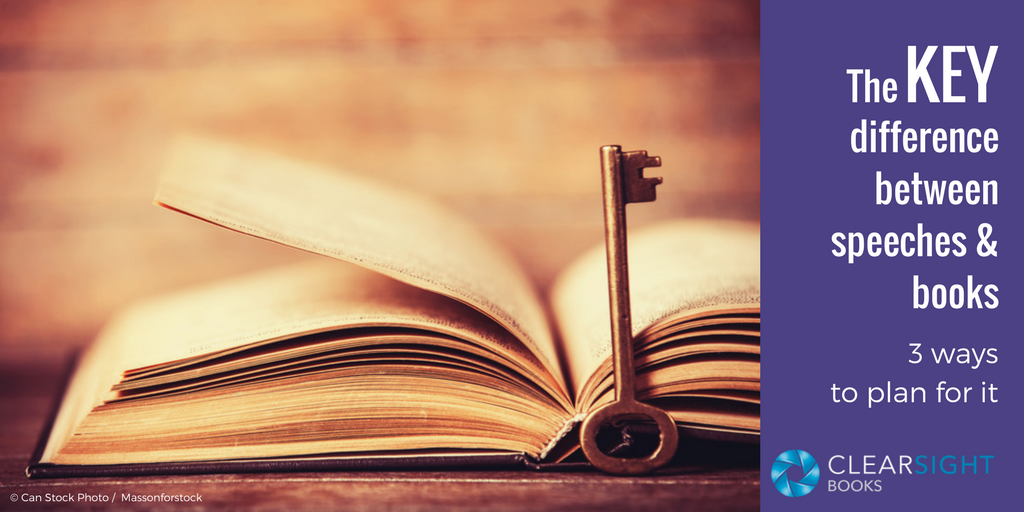
Many of Clear Sight’s clients are both speakers and authors—not surprising, considering what speaking and writing have in common. Both benefit from strong storytelling, precise language, good construction, and unexpected imagery. There is a creative synergy as well as business synergy.
However, there is one key difference between writing a book and giving a speech: while a speaker can interact with the audience, a book must stand on its own. There is no real-time interaction for author and reader.
Challenges for the book author
This lack of real-time interaction leads to several challenges in book planning and development.
Engaging the audience
Speaking has a clear advantage with audience engagement. In addition to having a compelling message, you can have slides, play music, draw pictures on an overhead, ask the audience to shout out answers to questions, or call someone up on stage.
With a book, reader engagement really comes down to good writing. You can sometimes engage readers with reflection questions or “homework assignments,” but those approaches are unlikely to save dull writing.
Reading the audience
As a speaker, you usually have a chance to read the audience—what jokes they laugh at, what stories touch them, where they seem confused. You can adapt: if the audience seems bored, you can pick up the pace or insert a turn-to-your-neighbor activity; if they seem confused you can stop for questions.
Not so with a book. Once your book is out, it’s out. Readers bring their own experiences and interpretations to the reading experience. You don’t get to watch and change the words on the page as they read them.
Answering questions
When you present the latest in corn hybrids or the newest social media marketing approach, someone in the audience is sure to want clarification. Speakers get to take questions.
A book can’t. Your written words must make sense on their own. You don’t get to sit next to readers and explain what you really meant.
Determining the right pace and length
When you give a speech, you have an allotted time. Since you’re a good speaker, you know to how to adjust to end on time. If time is tight, you can pick up the pace or omit details; if you have more time than anticipated, you can add another story.
On the other hand, you have to choose one book length. Too long and readers skim or quit—or they never start because they’re intimidated! Too short and readers are left unfulfilled, or even feeling cheated.
Iterating and refining
If you’re a professional speaker, you have core speeches you give on a regular basis. Each time you give a signature speech, you have a chance to practice, assess, and refine it.
With a book, once it’s published, it’s published. Readers read the same book each time (at least until the next edition).
3 tools to address the challenges
All those things speakers can do as a result of direct audience interaction? Authors must do them on the front end (i.e., pre-publication). Three tools will help you hit the mark.
Audience analysis
Before you begin writing, analyze your audience. There’s a difference in writing to a C-Suite audience vs. a mid-management audience.
Consider your audience’s time available for reading, their interest in reading, when they read, what they read, what challenges they’re dealing with, how they go about solving problems, and so on.
A thorough analysis leads to better decisions about book content, length, structure, and formatting to match your brand promise as well as the readers’ needs. Audience analysis helps you write to engage your readers and helps predict what questions they will have.
A good editor
As you write, you’ll use your audience analysis to shape your content, but even the best writers leave gaps, phrase sentences awkwardly, or lack clarity.
A good editor sees the text through the readers’ eyes. She helps ensure a consistent and engaging voice and clear, concrete language to avoid questions and confusion whenever possible.
Beta readers
Beta readers are people you ask to read an early draft of your book. The book is close to done, but—this is important—you are still open to improving something significant about the book.
Beta readers usually include readers from your target audience and people knowledgeable about your topic, as well as people who know something about writing. Beta readers help you validate that your book matches your audience analysis. They help identify areas that need clarification. They ask the questions that you forgot to answer.
As you write and revise early drafts of your manuscript, you are of course iterating, but the beta reader stage is where authors get to iterate with real audience feedback.
Fly! Be free!
If you use these three tools, you will be in a much stronger position to publish your book. You will know you can let it go into the world without you by its side.
Need help reading your audience? I’m an excellent medium… Give me a call and I’ll get out my crystal ball and red pen.

